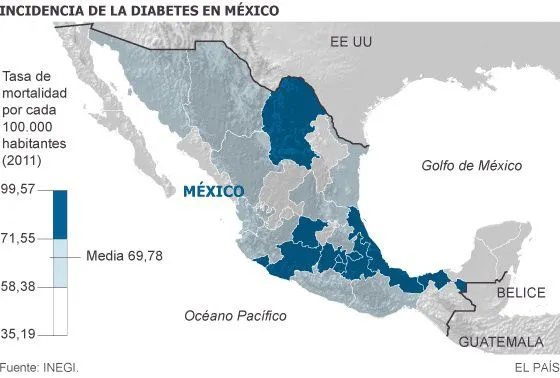Type 2 diabetes is the second cause of death among Mexicans, and their development, although preventable, is also influenced by gender inequality that causes women not to have healthy lifestyles, do not access appropriate medical services, and notThey can pay for the expenses of your illness.
Within the framework of World Health Day, which is commemorated today, it shouldone hundred of female deaths in that year.
For four years there has been an increase in the incidence of the disease, and growth is higher in women than in men, since in 2011 there were 442.23 cases per 100,000 Mexicans, in contrast to the 326.81 cases per 100A thousand men.
Which translates that there are currently approximately 10 million people with the disease, and it is estimated that by 2030 the figure grows at 16 million.
chronic condition
Alberto Lifshitz, specialist in internal medicine and researcher at the Faculty of Medicine of the National Autonomous University of Mexico (UNAM), explains in an article that diabetes mellitus is a set of diseases that are characterized by an insufficient action of insulin - HormoneResponsible for food glucose to be absorbed by cells and provide energy to the body -, which usually causes hyperglycemia (excessive amount of blood glucose) and vascular lesions.
At least two diseases that seem to have a different nature are distinguished: type 1 diabetes (DM1) and type 2 (DM2).
The latter accounts for more than 95 percent of cases, and for its development a family tendency has been identified to contract it, which translates into the fact that people are born with predisposition to the disease and depends on whether or not they are exposed tocertain environmental factors for the condition to develop.
Among the environmental factors that have a strong relationship with diabetes is obesity, recognized by health authorities as a public health epidemic.
For 2012, according to the National Survey in Health and Nutrition (Ensenut), 73 percent of women over 20 years of age were not in the right weight, 35.5 percent had overweight, and 37.5 percent presented obesity.
The Doctors Hortensia Reyes Morales and Nelly Salgado de Snyder, researchers at the Center for Research in Health Systems (CISS) of the National Institute of Public Health (INSP), in their article "Life and health styles in women" indicate that obesityIt is "an obvious consequence of the combination of the health lag of Mexican women with access to life styles (not healthy), mainly in the population that lives in urban areas."
Both experts state that lifestyles depend largely on people's social conditions, since the social, cultural and economic context can be in itself a risk promoter.
Gender gaps
The article that is part of the book "Women and Health in Mexico" - published by the National Academy of Medicine - points out that women's lifestyles are related "very closely with socially determined factors, such as social representationof the genre ”, since inequalities accentuated health and development.
They add that although the greatest female participation in paid activities has contributed to the elimination of gender disparities, it has also generated changes in the lifestyles of women that are not always healthy.Among these changes is the alteration of eating habits, in addition to the use andalcohol abuse
Doctors explain that a large proportion of Mexicans consume the so -called "fast food", which does not have the necessary nutrients and on the contrary they have a high concentration of carbohydrates and sugars.
Although a small proportion of the occurrence of obesity is genetic, the vast majorclass of work they develop, specialists say.
They add that once diabetes has developed, obesity continues to influence both the control of blood glucose, and blood pressure, which in turn leads to high levels of cholesterol.
"In this way these patients have a greater risk of developing cardiovascular complications and therefore more likely to die."
actions without results
Diabetes results in mortal complications, among which heart disease, stroke, lower member amputation, chronic renal failure, blindness, and at the same time imply a significant cost for national health systems and patients.
According to INSP, Mexico spends approximately 15 percent of the total health budget to address diabetes, being the second world worldwide that allocates the disease.
In 2010, the country cost 707 dollars (10 thousand 605 Mexican pesos) per year.
At least 6 percent (280 thousand people) of those who were diagnosed with diabetes in 2012 lacked some medical insurance, so they had to pay for the expenses of the condition, among which are specific treatments such as laser, amputations, and medicinesnecessary to control the disease.
In last January the World Health Organization urgently called nations to take actions to stop the number of deaths from noncommissible diseases (such as diabetes), since these sufferings make efforts to relieve poverty, and put poverty, and put intodanger the achievement of international development objectives.
In September 2013 Enrique Peña Nieto and the Federal Secretary of Health, Mercedes Juan López, presented the “National Strategy for the Prevention and Control of Overweight, Obesity and Diabetes”, which - they said - would become the pillar ofPolicies in preventive matters of these diseases.


